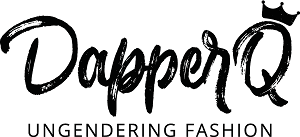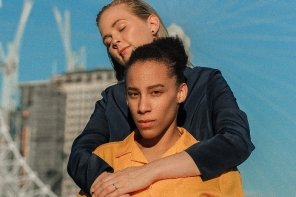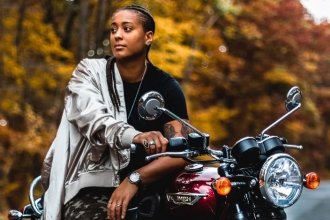Welcome back to Style Dossier, Gabrielle Royal’s column that profiles stylish queers across the country. This edition, Gabrielle is featuring Sue Westgate, a stylish dapperQ who does admirable work empowering individuals and families in crisis.
Bio:
Sue Westgate wears many hats, in both personal and professional life. Sue is currently employed as a clinical Social Worker in an Intensive Care Unit providing crisis management services and care coordination support to patients and families. In addition Sue is a graduate level adjunct professor and is simultaneously finishing up a Masters in Business Administration. Sue says, “So in essence, I am a bit of a proverbial shark that finds little value in using their teeth.”
Sue on style:
I have a penchant suits … and leather jackets. I find this sort of duality to be personally amusing. By day, I live a very corporate existence and have a string of suits, button-downs and polished black leather shoes that line my closet obtained from the likes of Calvin Klein, Kenneth Cole, Banana Republic, and Express for Men. Suits create the aura of power and seemingly instantaneously command respect and promote the sensation of personal confidence.
Outside the bounds of corporate America, I do enjoy my leather jackets purchased from Kenneth Cole paired with boot-cut jeans. I find that the most interesting of company has an equal liking for the brownish-red leather Kenneth Cole jacket that is featured in one of my pictures.
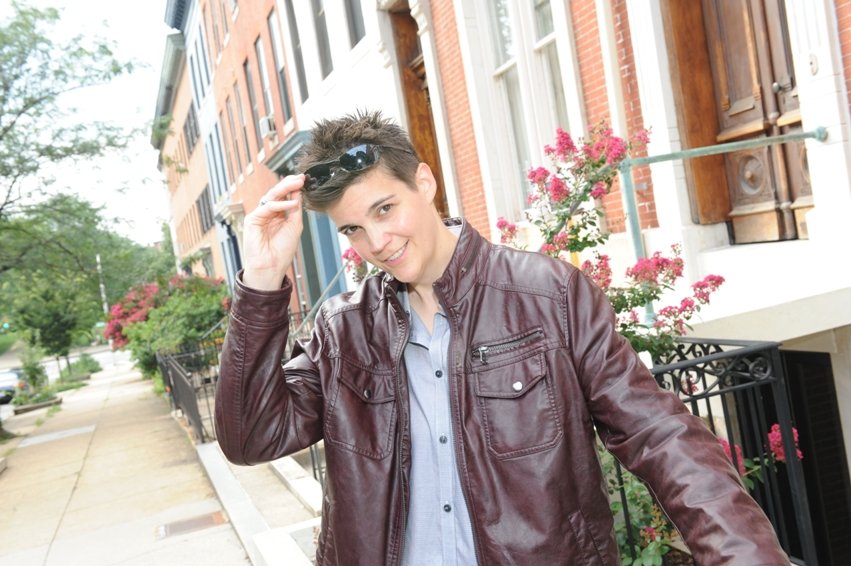
dapperQ: Who is your biggest fashion icon and why?
Sue: I cannot say that I have a particular fashion icon. However, I will concede that my style is ultimately a fusion of a plethora of iconic looks: the suited executive, the James Dean-ish leather jacket toting outlaw, and the unlikely marriage of New York City inspired extravagance and the artistic counter-culture of my hometown of Baltimore. There are always things that seemingly anchor my style: clean lines, a polished look, but all of these things hide a few tattoos and the underpinnings of a non-conformist identity! Fashion icons do not always do well with capturing the dimensions of gender and sexuality. I like to bend all of the aforementioned styles around those core elements.
dapperQ: How much of your personal style is influenced by your identity?
My style is absolutely a reflection of my identity. It is more than being a tomboy or masculine or butch or any other sort of poorly assigned and inadequate label. The way that I dress has always been a reflection of who I am in the moment. When I was young, I was a shy kid and dressed to hide. That tendency to be shy and to hide came in part from not having a grounded sense of what it was to be gay and feeling more on the fringe than in the center of things. However, as I have gotten older and assured in my identity, what I wear is a reflection of that flow of confidence. I now have far too many button-downs that pop. It is all ultimately the process of assembling my identity over time.
The way that I dress today is also highly purposeful. I have been told that I am quite good at orchestrating things. Working in the world of health care and in the ICU especially where crisis abounds has made me highly aware of how my presence impacts the patients and families that I serve. To my core, I want to help those that are in front of me and this necessitates presenting an identity that they can trust, that is counter to the cold environment around them, and that can make them feel at ease. I want to be able to build trust-based relationships with the various teams and administrators that I work with daily. My style, dress, color choices, and appearance in conjunction with the promotion of confidence in those moments is crucial.
dapperQ: Why is queer visibility important and how does fashion help create space for members of our community?
Sue: Queer visibility is critical in obvious and non-obvious ways. It can be an overt political manifestation of the creation of progressively safer social and public spaces. It can expand the ways in which we are able to express ourselves, celebrate our relationships, and conduct our respective daily lives. I think also about what it was like for me as a kid – painfully aware of being different and of being gay even though I did not have such words for myself yet. However, what I did have words for was the need to feel valued and the need for a future that would allocate a meaningful space for me.
Fashion is the symbolic means by which society gauges and ranks beauty. There is a profound need to expand our collective conceptualization of beauty. It is a natural inclination to want to see yourself or at least a piece of yourself in the world around you. Whether we like to admit it or not, this sort of personal alignment with fashion symbols and icons provides a deeper sense of validation. I am encouraged to see the increase in queer visibility, but I am also keenly aware that we have only begun this work and have much more ground yet to cover.
dapperQ: Tell us about your biggest fashion and/or shopping fail!
Sue: My sense of taste and fashion has historically been oriented around a few timeless staples. It is not in my nature to take significant style risks with what I wear or how I project my appearance. However, in an attempt to respond to this question, I opted to phone (or really text) a friend. My best-friend’s response to this question was, “Going to a place that does not value your hotness.” While this response is seemingly tongue and cheek, it is not without some solid truth. We cannot deny that our perceptions of ourselves are shaped by our social environment. There is no bigger fail than purposefully subjecting yourself to an environment that does not value your hotness.
dapperQ: What advice would you give our readership? What advice can you offer to people who fit outside of society’s understanding of traditionally masculine and feminine styles?
Sue: First, I would share that everything about the work that I do serves as a perpetual reminder for how valuable each day is. Every day I bear witness to life and death, to situations that permanently alter the trajectory of someone’s existence, and that shape the memories of their loved ones. Doing this kind of work has made me very aware of how I spend my time and energy. It has made me very aware of the need to live more fully and without fear. It has also made me very aware of how I would like to impact the world around me. In seeing these sorts of moments I always marvel at how the things that would otherwise divide us seem so much less important. I would challenge whoever reads this article to think about the value of your time and energy, the need to live more fully and without fear, the value of the impact that you can make, and how unimportant most points of hurt ultimately become when challenged with the bigger picture.
Second, I would offer that we need to stop perpetrating the myth of the gender binary. Far too often we conceptualize and position our sense of ourselves based upon a scale that is ultimately false. Such deeply entrenched bad habits negatively impact one’s inherent sense of worth and value. Ultimately changing these bad habits requires each of us to be a voice for one another. It is entirely possible that we are the exact sort of people that we are meant to be and that we have to reshape the world around us rather than let that same world reshape us against what is ultimately in our nature.
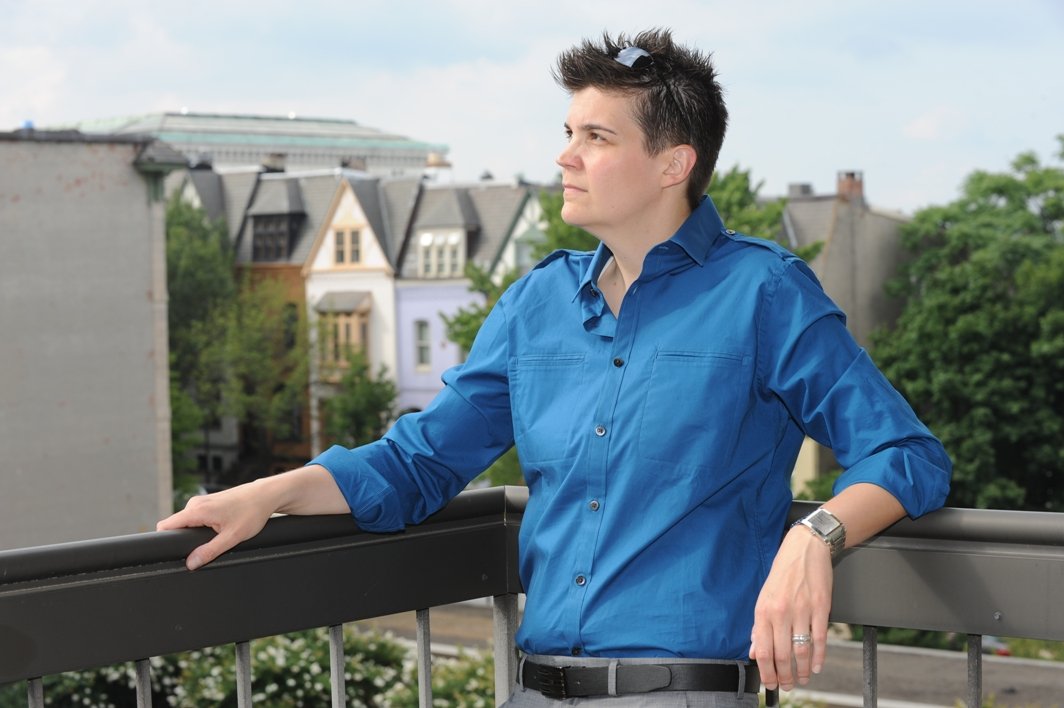
dapperQ: Tell us something unique about yourself.
Sue: I have a ridiculous and what could be labeled a photographic memory. This talent started initially as an adaptation to being dyslexic, was strengthened by working in a restaurant for years, and was cemented over the time in the world of academia. Before working in the world of health care, I worked with close to 500 individual clients and if pressed enough I could likely remember each one and their story. Call me the gay Erin Brockovich! The same goes for a majority of my patients that I have cared for over the years. This unique quality has been called everything from remarkable to inconvenient. I think one of the most important things that I can do for people is to remember them – to capture, carry, and protect their stories. Some of the most remarkable connections in my life assign the same value to collecting memories and stories.
dapperQ: How did you hear about dapperQ? Why were you interested in a feature?
Sue: A friend of mine actually turned me onto dapperQ. I randomly posted a picture of myself on social media and she suggested rather emphatically that I look into submitting a photo or two for this publication. I honestly did not initially take it seriously. In the process of talking myself out of doing this, I heard some recent advice echo in my mind, “Say yes and ask questions later.” I ultimately submitted some pictures and was surprised to learn of dapperQ’s interest. What intrigued me the most was that this publication features a good balance between the look and the person behind the look.
dapperQ: How can our readers stay connected with you?
Sue: You can find me on Facebook as well as on LinkedIn
Photography credit: I would like to give credit to and profusely thank the highly talented Jim Burger for taking these amazing photos for this article. To learn more about him and his fantastic work, please visit his website: www.burgerphoto.com
